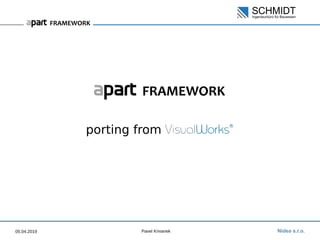
apart Framework: Porting from VisualWorks
- 2. 05.04.2019 Pavel Krivanek started in late 2016 by Richard Uttner support of an existing application – per documaps – document management target: – domain-specific solutions – database-centric – fat clients with platform-specific GUI
- 5. 05.04.2019 Pavel Krivanek layers separation minimize redundancy, improve re-usability minimize work required for the UI and “glue” layers improve testability support for the common business application patterns ... goals production quality small business application in few days
- 6. 05.04.2019 Pavel Krivanek modelling level: – parts forming the “skeleton” of the application – objects exposed by parts (conditions, values, actions) UI level: – generic GUI clients of the framework – application specific objects (widget, models,…) “glue” level: – arbitrary objects (startup, environment, use cases,...) participants and roles
- 7. 05.04.2019 Pavel Krivanek Clients separation
- 9. 05.04.2019 Pavel Krivanek data aspects (redirections) conditions – a user can see the reason why something is disabled (APCondition on: [stringField size > 0] ifNot: #StringFieldIsEmpty) & self enablementInputEnabled actions, triggers subpatrs Parts
- 10. 05.04.2019 Pavel Krivanek predefined parts (for lists, trees…) enumerations (combo-boxes, menus...) prompts, modal windows layouts Glorp Trachel aPart
- 11. 05.04.2019 Pavel Krivanek connected via: – their creators (typically parts) – framework condition objects – part actions – callbacks to parts maintaining separation from GUI do not reference parts, initialized with objects needed for running named callback requests (from the creator) workflow editor use cases
- 12. 05.04.2019 Pavel Krivanek typically just GUI clients headless clients, forwarding clients… particularly useful for tests aPart entities with native support of state changes records recording client clients
- 13. 05.04.2019 Pavel Krivanek open recording client on your part with SUTAPInteractionPrinter, manual interaction use the generated SUnit test code unit tests repeat the interactions, check states prompts/multiple windows support automatic unit tests code generation self afterDoing: [ self setAspect: #stringField value: 'foo'. ] expectStates: [ APExpectedStates expectAllInactive: #(#clearNumber #confirmNumber #saveData) expectAllActive: #(#clearString #confirmString #disableInput #intField #stringField) ].
- 14. 05.04.2019 Pavel Krivanek developers should prefer the framework not always the most straightforward solution framework usage
- 15. 05.04.2019 Pavel Krivanek framework usage locate functionality? dependencies? estimations? impacts? plan tools additional effort
- 16. 05.04.2019 Pavel Krivanek from VisualWorks part of porting of per documaps application close collaboration with Pharo Consortium and INRIA (RMoD) port to
- 17. 05.04.2019 Pavel Krivanek Language differences – namespaces Store.Model UI.Model – qualified literals #{UI.CheckBoxSpec} – FFI calls <C:typedef int64_t (*callb_after_send_t)(unsigned char* handlerID, int PortServerID, unsigned char* inputBuffer, int cbInput)> Challenges
- 18. 05.04.2019 Pavel Krivanek Challenges Semantics differences – object initialization (new) ● inherit from class that behave differently – same methods with different behavior (Pragma>>#selector) – dependencies mechanism – (#Smalltalk = 'Smalltalk') = false – 'asdf' readStream upToAll: 'd'; upToEnd ● 'f' in Pharo, 'df' in VW – and many more…
- 19. 05.04.2019 Pavel Krivanek Challenges Different code management tools, source formats – VW: Store, XML – Pharo: Git Completely different UI framework – UI Painter, different data flow ● VW: Aspect adaptors ● Pharo: Value holders
- 20. 05.04.2019 Pavel Krivanek Challenges Application strongly Windows oriented – first-and-half-class citizen in Pharo Application still under active development – bi-directional transformation Target platform under active development – Spec2
- 21. 05.04.2019 Pavel Krivanek Why should you care? Most of us will port applications to Pharo ...if you are lucky, from some older Pharo version
- 22. 05.04.2019 Pavel Krivanek Approach export code from VW in XML form (*.pst) (not stable order, unusable for versioning) import into Ring2 model – modified scanner & parser apply well known code transformations store VW metadata (for reverse direction) save Ring2 model in Tonel format manage with Git load into Pharo
- 23. 05.04.2019 Pavel Krivanek Tests! with so many small hidden incompatibilities, tests are absolutely necessary good code coverage, mutation testing, UI tests cheap in long term
- 24. 05.04.2019 Pavel Krivanek UI layers adoption VisualWorks Pharo – “compatible” ApplicationModel – UIBuilder replacement
- 25. 05.04.2019 Pavel Krivanek Future aPart Framework will be open-sourced native UI with Spec2 (GTK) full-featured reference example including database handling with Glorp extended documentation workflow editor...
- 26. 05.04.2019 Pavel Krivanek the side-effect of SCHMIDT, Pharo Consortium and INRIA collaboration for you business better
